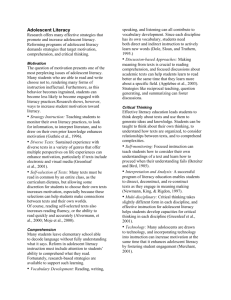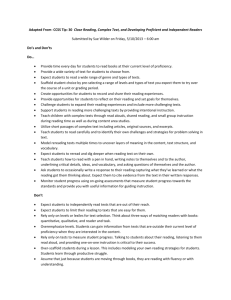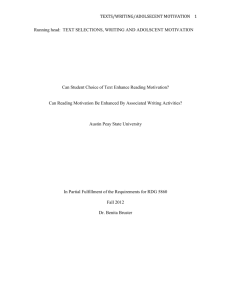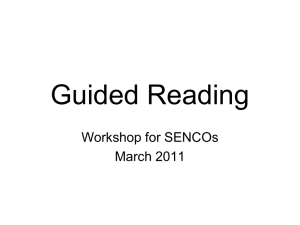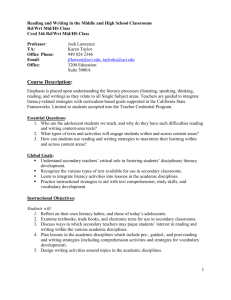File
advertisement
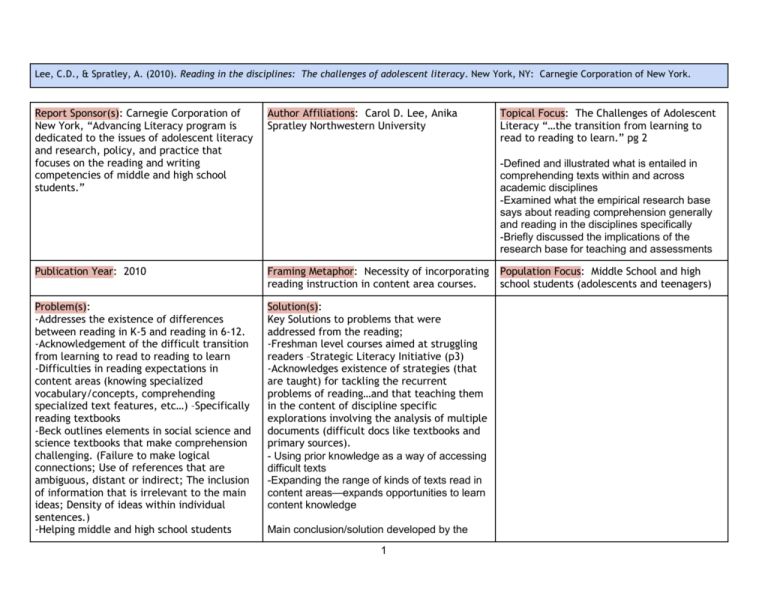
Lee, C.D., & Spratley, A. (2010). Reading in the disciplines: The challenges of adolescent literacy. New York, NY: Carnegie Corporation of New York. Report Sponsor(s): Carnegie Corporation of New York, “Advancing Literacy program is dedicated to the issues of adolescent literacy and research, policy, and practice that focuses on the reading and writing competencies of middle and high school students.” Author Affiliations: Carol D. Lee, Anika Spratley Northwestern University Publication Year: 2010 Framing Metaphor: Necessity of incorporating reading instruction in content area courses. Problem(s): -Addresses the existence of differences between reading in K-5 and reading in 6-12. -Acknowledgement of the difficult transition from learning to read to reading to learn -Difficulties in reading expectations in content areas (knowing specialized vocabulary/concepts, comprehending specialized text features, etc…) –Specifically reading textbooks -Beck outlines elements in social science and science textbooks that make comprehension challenging. (Failure to make logical connections; Use of references that are ambiguous, distant or indirect; The inclusion of information that is irrelevant to the main ideas; Density of ideas within individual sentences.) -Helping middle and high school students Solution(s): Key Solutions to problems that were addressed from the reading; -Freshman level courses aimed at struggling readers –Strategic Literacy Initiative (p3) -Acknowledges existence of strategies (that are taught) for tackling the recurrent problems of reading…and that teaching them in the content of discipline specific explorations involving the analysis of multiple documents (difficult docs like textbooks and primary sources). - Using prior knowledge as a way of accessing difficult texts -Expanding the range of kinds of texts read in content areas—expands opportunities to learn content knowledge Topical Focus: The Challenges of Adolescent Literacy “…the transition from learning to read to reading to learn.” pg 2 -Defined and illustrated what is entailed in comprehending texts within and across academic disciplines -Examined what the empirical research base says about reading comprehension generally and reading in the disciplines specifically -Briefly discussed the implications of the research base for teaching and assessments Main conclusion/solution developed by the 1 Population Focus: Middle School and high school students (adolescents and teenagers) (especially struggling readers) develop conceptual understanding of the knowledge sources/features in texts, which help them understand texts at a deeper level. p 10 -Comments on the lack of understanding of math as a discipline with unique reading requirements-strategies to improve reading in mathematics (according to NCTM standards) at the secondary level are still relatively unexplored -Mathematics as a unique language/form of communication that must be recognized and understood before complete comprehension can occur end; -Moving past generic reading strategies to more discipline specific reading strategies in order to improve reading skill/comprehension in the content areas. In successful content area classrooms, teachers organize instruction in routine ways that; -Reinforce conceptions of reading as a meaning making process -Provide guided support -Shift responsibility for thinking/making meaning to students, through guided supports -Sequence discipline specific inquiry tasks and the reading of a range of texts in ways that build knowledge over time -Focus classroom talk on how students make sense of texts and how they use what they learn from texts to carry out tasks -Provide consistent supports Create culture of high expectations. Utilization of a variety of instructional routines for before, during, and after reading including; Teacher modeling Organizers/pre and post reading tasks/annotation guides Other Observations: -Varying requirements of a typical reader in Science, History were covered, but solutions/techniques for success in reading in these disciplines was limited -At the end, the sampling of current research projects regarding adolescent literacy/reading in the content areas was interesting because they show a variety of 2 different programs all taking part in studying the methods good readers employ, in hopes of taking the skills and techniques they exhibit to students who are struggling as readers. Brief Summary: Key points -Overall the article outlines the different kinds of reading done in each content area (including the differences and similarities between the kinds of texts in each discipline) -Outlines difficulties in social science and science courses (textbooks and primary source material) -Encourages integration of reading instruction in content area courses, which meet diverse reading needs of students and teach all students to reason in the complex ways that the disciplines require. -Addresses the importance of learning to read literature and the problems that are inherent in how it is taught/how these problems contribute to the difficulties that struggling readers face. -Discussed samples of reading in each discipline and what is required with the different kinds of reading -Discussed what students need to know and value in regards to their reading From the research discussed; -Reading strategies-pre-reading, predicting, testing hypotheses, asking questions, summarizing, accessing prior knowledge, etc… should be utilized as a means of accessing/leading into more discipline specific reading strategies (prior knowledge, building specialized vocab, deconstructing a text, posing deeper, more focused questions, etc… ª ‘Crisis’ is a common metaphor used to frame the focus on adolescent literacy. Various types of crises can be employed: moral crisis, economic crisis, achievement crisis, competitive crisis, technological crisis, etc. The framing metaphor is often not named explicitly, but is implied or inferred in the language used to frame the argument that a certain problem exists. Thus, identifying the metaphor requires close, critical, and/or deconstructive reading. 3



